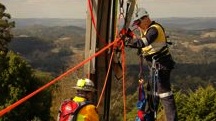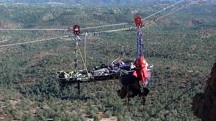In fact, it is for those that never seem to get enough on rope experience or time over the edge. The BIC begins with valuable, yet simple lessons on physics, safety in the vertical realm and then moves into practical and fun-filled days where multiple rope stations keep the practitioner busy throughout the day. Students in the BIC practice their skills and learn to work together as a team in successful retrieval of this patient in a non-threatening environment. The BIC goes well into often overlooked personal skills that are taken for granted on most rescue teams. Students also learn the classic differences (in risk) associated with belays, self belays, conditional belays and conditional self belays.
Warning: There is a very very strong emphasis on knotcraft in this seminar! Students are tested throughout the program for proficiency and the ability to tie under pressure. All in fun, of course!
BIC key points:
• Ideal for rope access technicians (those that work at elevation).
• Strong emphasis on personal skills
• Improvisation and minimalism "What do you do if the gadget does not show up?"
• Knotcraft to the extreme (There is a strong emphasis on knot skills)
• Introduction to pulley systems (simple through complex)
• Physics of rope rescue
• Two tensioned rope systems
• Beginning litter work in high angle evacuations (practice at "attending")
• Multiple methods of descending on rope (including improvised)
• Multiple methods of ascending on handled ascenders
• Rope-to-rope transfers
• Rope problems needing strong personal skill base
• Emergency escape
• True belays/escaping belays after loading
• Self rescue techniques / Buddy rescue techniques
• Complete AZTEK kit orientation for personal and team operations:
Single and double part hasty rappels
Belays and self belays
Dynamic fixed and traveling brakes
Dynamic directionals
Personal travel restrict and fall protection
• Solo rescuer pick off ("gecko" and hanging)
• Semi-solo rescuer pick offs ("gecko" and hanging)
• Sound anchoring principles: simple through advanced system anchors
• Slack backups vs tensioned backties
• Patient tie in techniques
• Split coil carries; low angle carries
• Caterpillar passes and role rotation during litter carries
Much more....



